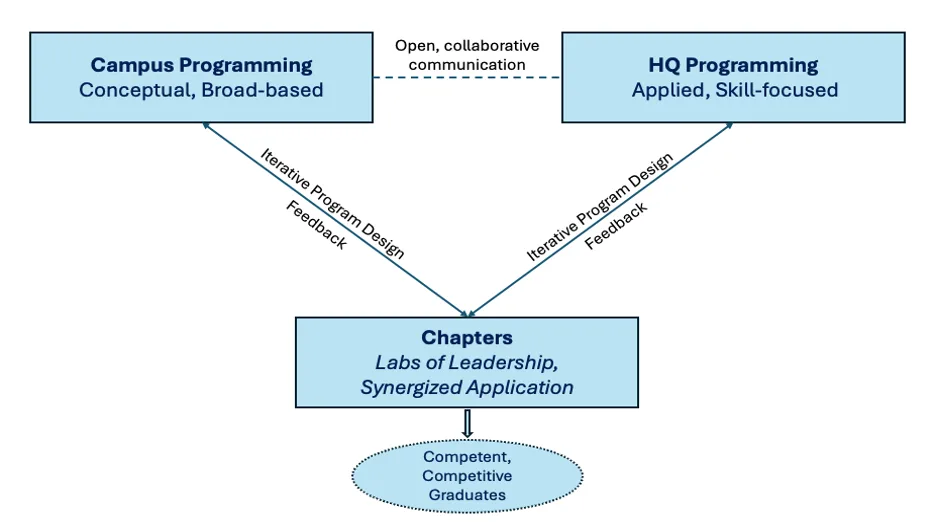When was the last time your organization studied or defined its value proposition? What specifically, for the student in 2024 and beyond, does membership in the organization provide – at additional cost – that students cannot otherwise get for the price of tuition? These are questions I have posited to my students since I started my professional journey in the fraternity headquarters field over six years ago. They continue to be guiding questions for my work as I continue to think about the long-term trajectory of our organizations and their relevance in the lives of new generations of students.
In a Perspectives article from June 2023, an assertion was made about reframing the scope of fraternity and sorority life (FSL) professional positions in a post-pandemic setting, specifically by “reevaluating the workload (of campus staff), eliminating low-impact programs and services, providing meaningful professional growth opportunities, and strengthening onboarding and retention practices” (Bureau, McDonald, Nuttleman, & Wrona, 2023). This mindset should apply equally to our student leaders and members and strikes at the heart of defining our value propositions as organizations.
I have long believed that fraternity and sorority organization education programs can generate a higher value proposition by avoiding duplication of content generally offered by campus programs. Some topics are necessary to include from both lenses (e.g., health and safety, inclusive practices, etc.), but our chapters are also laboratories of leadership; they provide the applied learning opportunities to complement classroom instruction. The experiences students gain are the differentiators for our members when they enter the workforce or graduate programs after graduation.
In a conversation I had with Katie Lloyd, a senior director at Alvarez & Marsal focusing on early career development with 30 years in MBA program leadership in April 2024, I learned our students are entering the workforce with excellent “book” knowledge but obvious gaps in “practical” skills. Examples included skill gaps in general professionalism, online presence, interpersonal skills, presentation skills, etc. Other mentions included tech skills such as PowerPoint, Excel, and project management. In my own internal surveying and research, the main point of feedback about Delta Kappa Epsilon’s (DKE’s) learning opportunities summed up to this: “We [the student (leaders)] want to learn how to do the job.” Michelle Day (2024) notes in an article that 40% of Gen Z students are not prepared for the workforce. From an industry perspective, the biggest trend in learner desire is “the increasing importance of career development” (Loutfi-Hipchen, 2024).
Let’s imagine our organizations lead the charge in focusing on applied learning to complement conceptual learning. Regardless of where they end up, our students develop critical workforce skills during their chapter experience. Shifting our approach to education toward that of talent management, we boost our value proposition such that we give our members early access to what it’s like in the workplace – and the leg up our members are likely selling during recruitment.

How does leveraging Artificial Intelligence (AI) relate? Obviously, a shift in our approach can snowball into possible overwhelm, especially if you find yourself in a situation like mine when I started leading education efforts – having to start de novo. However, consider the following:
- AI can increase productivity capacity, especially for small teams.
- AI can reduce tedium and project timelines when designing learning experiences, particularly with innovative e-learning design platforms and automation capabilities.
- AI can reduce the stress on instructional designers to be “experts” in all things and topics, including keeping up with trends.
- AI is a mutually beneficial tool, with “fringe benefits” for all parties.
Where do we start? Ricci Masero (2024) lays it all out plainly; the future of impactful and engaging learning and development rests in effective adoption and implementation of AI. Masero’s article provides a useful primer in the fundamentals of AI. Other e-learning options are available, too, at low or no cost for learning designers. I chose to complete a certification from Quantic, focusing on transforming business with AI and ChatGPT. As learning designers and professionals, the best place to start is investing in ourselves.
Next, I suggest focusing on the critical element of utilizing AI tools – prompt engineering. Your success with AI tools is almost singularly dependent on your prompts. Whether you’re using a chat bot, a design bot, or whichever model, ensuring inputs effectively guide the bot in generating desired outputs is the difference between a headache and mistrust and supercharging learning design abilities. Check out this article from OpenAI about prompt engineering.
DKE’s programmatic transformation leveraging AI began because of all those considerations and the steps I took to invest in my own knowledge and skill. From there, we sought ways to explicitly use AI in our work.
Here are the models and systems I currently use and how:
- AI – an easy e-design tool that reads documents and PDFs and can create course drafts; also includes internal AI-driven image design tool; used for micro-learning and open-access content
- ChatGPT – used for survey development, live training content ideation, trend research and summation
- Canva – the easy-to-use platform for multimedia deliverable generation
- DekeConnect – a customized platform that allows mentorship conversations based on selected inputs that connect students with alumni directly
Here are systems I am exploring:
- Articulate AI – usable in RISE and Storyline to speed up content creation
- Inncivio – an online platform that offers the ability to input content from the design team, but also utilizes AI to generate independent learning pathways for members on topics in which they’re interested
The results? We have constructed two Officer Academies, one Emerging Leader Academy, a Convention, an Education Department master plan, a wellness program framework, and several micro-learn lessons, all at or under budget, before deadlines, and without expensive outsourcing. When I assumed my role, it was unimaginable to me that one person could manage all of this. Thanks to AI, our capacity to produce was supercharged, project times were streamlined and shortened, research time was slashed, and our team is getting used to integrating these tools in their own work. Simply put, (almost) anything is possible.
Our organizations are critical contributors to the student experience, but despite the positive data and street cred we may have, we should never get complacent in thinking we have mastered our crafts. Fraternities and sororities can play principal roles in ensuring students are prepared for success, and that starts with ensuring our practices and tools are modernized and current with the experiences members will face after they graduate. If we can do that, we seldom have to ponder our value proposition. We become the sought-after experience for good, because our students gain something. Wherever your organization is in its existence, I would strongly recommend exploring ways to adopt AI.
Ultimately, too, if our campuses and headquarters can work together to strategically design educational programs that complement each other, and augment that design with these tools, the entire industry stands to benefit. Imagine if one day after we have transitioned to such a state, we are able to combine resources to create an AI model that generates health and safety plans for students’ events using all the available industry knowledge? With a few controls and advisory input, we may just get them to reap the benefits of a truly healthy, safe, and fun fraternity/sorority student experience.
References
Bureau, D., McDonald, S. K., Nuttleman, K., & Wrona, D. (2023, June 15). Rewriting the Playbook: Post-pandemic priorities for fraternity/sorority life. Retrieved from AFA Perspectives: https://afa1976.org/rewriting-the-playbook-post-pandemic-priorities-for-fraternity-sorority-life/
Day, M. (2024, January 12). Bridging the Skills Gaps Between College and the World of Work. Retrieved from Training Industry: https://trainingindustry.com/articles/workforce-development/bridging-the-skills-gaps-between-college-and-the-world-of-work/
Loutfi-Hipchen, E. (2024, March 7). New LinkedIn data reveals AI’s impact on L&D and business. Retrieved from Chief Learning Officer: https://www.chieflearningofficer.com/2024/03/07/new-linkedin-data-reveals-ais-impact-on-ld-and-business/
Masero, R. (2024, February 28). AI’s True Potential In L&D And The Workplace. Retrieved from eLearning Industry: https://elearningindustry.com/ais-true-potential-in-ld-and-the-workplace

About the Author
Dustin Stewart is the Director of Education at Delta Kappa Epsilon Fraternity and is pursuing his Education Specialist degree in Instructional Design & Technology. He is a member of Sigma Alpha Epsilon Fraternity and has been active in the Greek community for 10+ years.



